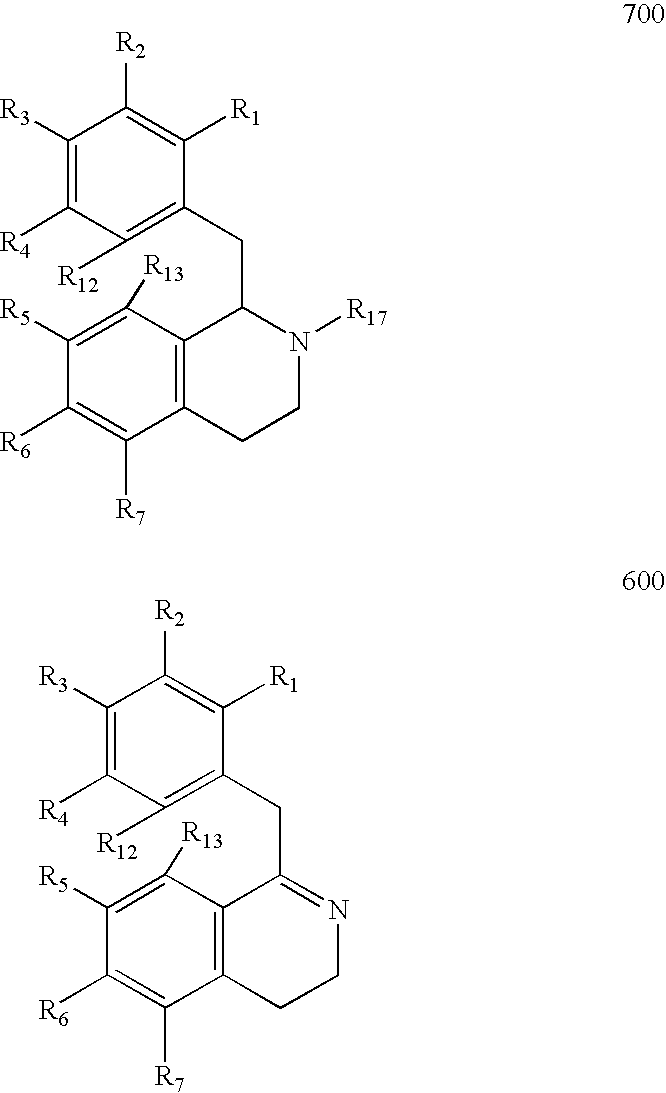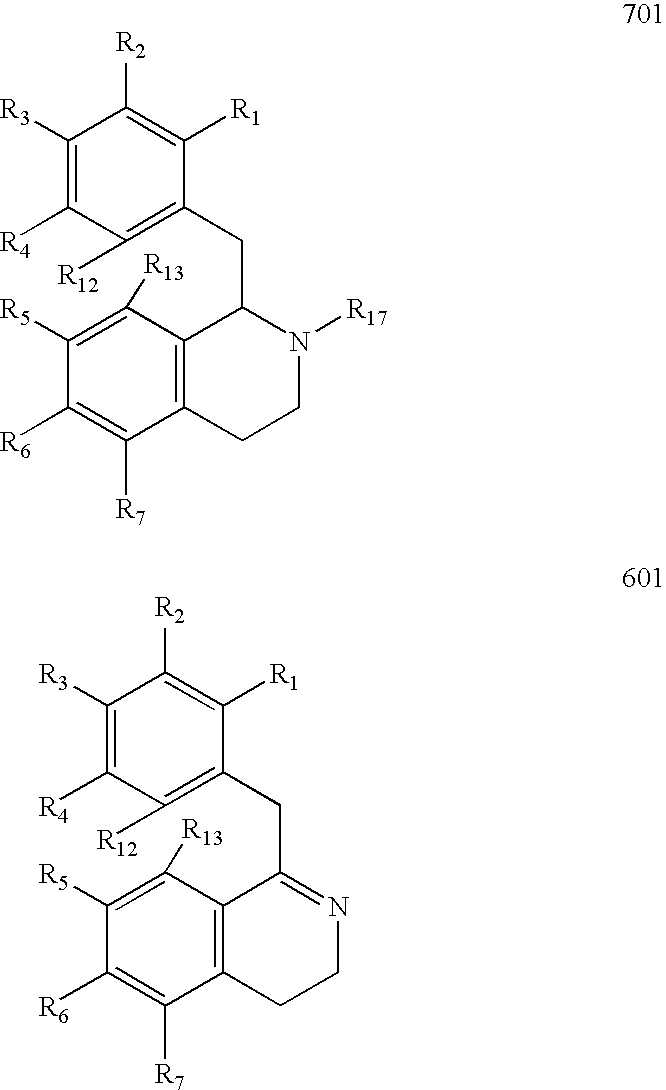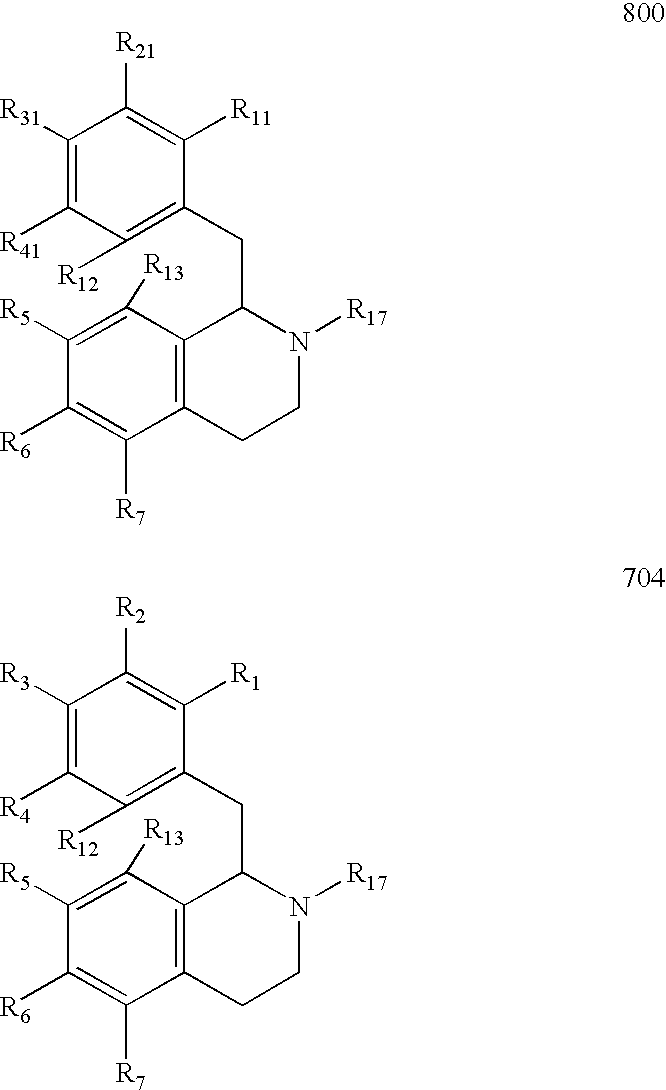Process for the Preparation of Hexahydroisoquinolines from 1,2,3,4-Tetrahydroisoquinolines
a technology of hexahydroisoquinoline and tetrahydroisoquinoline, which is applied in the field of synthesis of hexahydroisoquinoline, can solve the problems of adding an extra step and reducing the yield of the desired enantiomer
- Summary
- Abstract
- Description
- Claims
- Application Information
AI Technical Summary
Problems solved by technology
Method used
Image
Examples
example 1
Preparation of Compound 711 from Compound 611 and Compound 712 from Compound 612
[0111]
[0112]To a 5 L dried reactor under inert atmosphere, was added acetonitrile (1.4 L, anhydrous). To the acetonitrile, triethylamine (455.8 g, 4.5 moles) was introduced. The reaction flask was chilled to 5° C. 98% Formic acid (548.1, 8.75 moles) was added dropwise while maintaining the temperature below 30° C. After the formic acid was added, the formed salt solution was degassed for 1 hour. Compound 610 (434.5, 1.36 moles) was added all at once followed by 3.0 g dichloro(p-cymene) ruthenium (II) dimer and 3.0 g of (1S,2S)-(+)-N-4-toluenesulfonyl)-1,2-diphenylethylene-1,2-diamine. When Compound 610 was used as the starting material, an additional 1.0 equivalent of 98% formic acid was added to convert the Na salt to the phenol in situ. The reaction initially turned green, then slowly changed to yellow. The reaction mixture was stirred for 16 hours at room temperature. HPLC indicated the reaction was c...
example 2
Preparation of Compound 811 from Compound 711
[0114]
[0115]To a 5 L dried reaction flask was added Compound 711 (392.5 g, 1.14 moles), isopropyl alcohol (500 mL, anhydrous), and tetrahydrofuran (1.0 L, anhydrous, inhibitor free). The obtained slurry was cooled to −60° C. Anhydrous ammonia (approximately 1.5 L) was condensed into the slurry. The mixture was stirred for 30 minutes while maintaining the temperature at −60° C. Then, lithium metal (30.2 g, 4.35 moles) was added to the reaction mixture in 5 portions over an hour period. After the last addition, the color of the reaction was blue. HPLC analysis indicated the reaction was complete. Then, anhydrous methanol (400 mL) was added dropwise. After the addition was complete, the reaction mixture was slowly warmed to room temperature (approximately 8 hours with good stirring) allowing excess ammonia to evaporate. Distilled water (750 mL) was added to the mixture. After stirring for 30 minutes, glacial acetic acid was added slowly to a...
example 3
Preparation of Compound 711 from Compound 611
[0117]
[0118]Triethylamine (1.06 g per gram of Compound 611) and acetonitrile (6 mL per gram of Compound 611) were added to a reactor equipped with a mechanical stirrer. Formic acid (1.2 g per gram of Compound 611) was added in four portions to the reactor resulting in an exotherm. The reaction temperature was controlled below 80° C. during the addition. After cooling to room temperature, a solution of 5 equivalents formic acid to 2 equivalents triethylamine in acetonitrile was formed. Compound 611 was added to form a suspension. It was flushed with nitrogen for 15 min and the Ru catalyst 111 described below (0.01 g per gram of Compound 611) was added. The suspension was again flushed with nitrogen for 15 minutes and stirred at room temperature for 10 hours. The end point of the reaction was determined by HPLC (Compounds 711:611 were >99:1). The mixture was diluted with water (9 mL per gram of Compound 611) until dissolved. To the solution...
PUM
| Property | Measurement | Unit |
|---|---|---|
| temperature | aaaaa | aaaaa |
| temperatures | aaaaa | aaaaa |
| temperatures | aaaaa | aaaaa |
Abstract
Description
Claims
Application Information
 Login to View More
Login to View More - R&D
- Intellectual Property
- Life Sciences
- Materials
- Tech Scout
- Unparalleled Data Quality
- Higher Quality Content
- 60% Fewer Hallucinations
Browse by: Latest US Patents, China's latest patents, Technical Efficacy Thesaurus, Application Domain, Technology Topic, Popular Technical Reports.
© 2025 PatSnap. All rights reserved.Legal|Privacy policy|Modern Slavery Act Transparency Statement|Sitemap|About US| Contact US: help@patsnap.com



